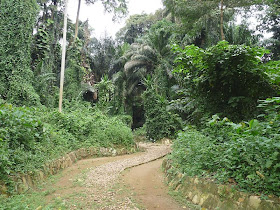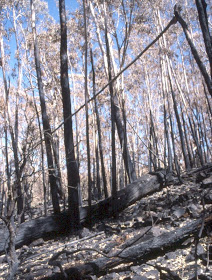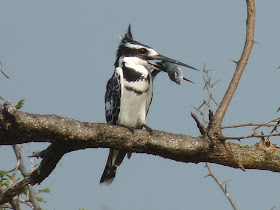On this day exactly ten years ago – 18 January 2003, a date
branded into Canberrans’ minds – the unimaginable happened. Bushfires of
incredible intensity crashed into the south-western suburbs and in the space of
a few hours destroyed more than 500 homes; more than 200 of them were in the
suburb of Duffy where I now live, some 17 in my street alone. It still feels hard
to accept that such a thing could happen in a modern capital city. Tragically
four people died, but in the shocked confusion it seems miraculous that the
number wasn’t far higher, as people fled along streets choked with burning
debris, including cars, fallen power lines and dense smoke.
This is a very different blog from any I’ve written and I
hope you can forgive me my self-indulgence. It’s something I need to write
about; even now I find my fingers trembling as I type.
Eleven days earlier, on 7 January, during perhaps the most severe drought for a century, major electrical
storms swept across south-eastern Australia, starting a series of fires in the Alpine National
Park of Victoria before moving north. The next day 40
fires erupted along the western fall of Kosciuszko
National Park and another
five along the Brindabellas on the Australian Capital Territory ’s western border. Despite heroic fire-fighting efforts the
fires continued to grow steadily. On the 18th – a Saturday – temperatures were around 400C, and winds
were in excess of 100 kilometres an hours. Catastrophe was inevitable. Another
fire came roaring up the steep western slopes from New South Wales, joining with the
Brindabella fires; such a situation creates huge bursts of activity, hurling
burning material kilometres ahead. A vast open roaring furnace swept down into
the Cotter River Valley, up over the Tidbinbilla Range and
engulfed the entire much-loved Tidbinbilla Nature Reserve. Rangers sheltering in the new visitor centre,
including people I knew well, very nearly died; had they still been in the old
one they certainly would have. From there it was possibly only 20 minutes to
the suburbs.

I then lived on the other side of town. Like tens of
thousands of us, I spent the day glued horrified to the wonderful local ABC
radio station (666!); most of management was on leave, and staff started coming
in spontaneously to begin what was to be a marathon of emergency broadcasting.
For that time, during the crisis and well beyond it during the major recovery efforts,
666 was the essential source of fire-related information and communication.
I watched the sky spread bruised orange and purple from the
south, in helpless anguish for suffering friends and fellow Canberrans, and
apprehensive about what might be coming my way over the adjacent Black
Mountain. In days to come I continued listening, stayed away from the south-side
to respect people’s grief, and in due course went over and helped friends sift
the ashes of their life in the hope of finding physical scraps of the past to
carry into the future. So far, my story was just that of any of us who were
here at that time and not directly affected.
Like everyone I tried to do my bit, and my role became one
of helping to keep Canberrans informed in the subsequent weeks of the situation
in the ranges, particularly Tidbinbilla Nature Reserve and Namadgi National Park. I was 666’s ‘resident
naturalist’ with a regular broadcast slot. Because of this I was approached by
ACT Parks and Conservation and asked to accompany them on tours of inspection
of areas which would be closed to the public for months to come, and report on
them. Emails I later got in response to my reports confirmed that indeed this
was something that many people – including those who’d lost everything – wanted
and needed to know.
For twenty years Namadgi had been my back yard. I’d written
two natural history guide books and a wildflower guide about it and I knew and
loved the park as well as most people. One of the more useful things I’ve done in
my life was to write a report in 1991 which assisted in getting the northern
part of the Brindabellas included in Namadgi.

Six days after the fires I was taken to Tidbinbilla.
From within the Weston Creek suburbs all the way out to Tidbinbilla – and on a
second trip later all the way up into the Brindabellas in Namadgi – I saw scarcely
a square metre of green. The one exception was a metre-wide ribbon of tree
ferns in one creek line on the eastern slopes. On the plains trees were bent
parallel to the ground by the inconceivable ferocity of the fire winds. Paddocks
that had been eaten bare to the ground by stock somehow carried a fire so
intense that it burnt through the base of power poles. I saw endless thousands
of hectares of burnt trunks and no leaves; in some slightly less intensively
burnt areas the dead leaves were beginning to fall. On the steep western slopes, soil
had had all the organic material burnt out of it – it didn’t even feel like
soil. Great granite boulders were shedding layers of skin.
The lush wet eucalypt forest gullies at Tidbinbilla,
with some of the most beautiful and soothing walks I know, contained just stark
leafless trunks standing over utterly bare ground and the oozing creek. Tree
ferns had vaporised. “It’s Mordor” I wrote at the time. I watched the surreal
movement of the two stoical workers in white overalls and breathing masks moving
through a skeletal landscape collecting six day old carcases and piling them
into a truck to take to the pit, 16 metres long, 3 metres wide and four metres
deep and filling. When I stared down into it there were already over 500
kangaroo and wallaby carcasses in it, plus 130 sheep from neighbouring
properties. A couple of koalas were added as I watched. It was – literally for
me – the stuff of nightmares. The memory of the stench stayed with me for a
long time; even after a shower that night I could still taste it.
| Burnt Alpine Ash, Namadgi National Park. |
A week later I was with the first Parks Service group high in
Namadgi National Park when we discovered that, contrary to earlier reports, the
internationally significant Ginini Flat sphagnum bogs had burnt, destroying
hundreds of years of water-holding moss growth. That was one of the bleakest
moments of my life. (The recovery work is still continuing; just last week
another fire nearly destroyed the efforts, but parks staff saved it.) In the
coming weeks I made further trips with rangers to chart the natural recovery,
which is an integral part of the nature of Australia. Those trips,
incidentally, helped my own recovery process. In the event 95% of Namadgi
National Park eventually burnt, and the fires were not finally extinguished
until rain on 21 February, 45 days after they started.
| Single sprouting eucalypt in burnt forest, 8 weeks after the fire. |
I initially sent my written reports to friends, and then to
a natural history chat-line. They ‘went viral’, as they say. I received emails
from all over the world. In less than three weeks I wrote over 300 emails to
people seeking more information and such reassurance as I could offer for the
future of the areas.
I guess the only reassurance is in the mighty cycles of nature;
we see only a tiny portion of a single cycle. The mountains have seen it all
before – though probably not in European
times – and will doubtless see it again, though hopefully not for centuries. The
Mediterranean landscapes of southern Australia are some of the most
fire-adapted in the world – I’ll certainly talk about that in a forthcoming
blog. The natural fire cycle of the Alpine Ash forests (Eucalyptus delegatensis) is probably of the order of 300-400 years;
we’ve not been here long enough to see a single cycle.
And life moves in unexpected
ways; after a pretty bleak couple of years I found love again soon after the
fires, as a direct result of the after-fire radio work, leading ultimately to
my move across town to the heart of the fire grounds.
| Hypoxis hygrometrica in a burnt landscape. |
Later that year, when I could take people up into the high
country, many of the trees were sprouting the fuzzy green cloak of epicormic
growth, and the ground flowering was like nothing I’d seen there. We drove
through 25 kilometres of a white carpet of Prickly Starwort (Stellaria pungens), which normally is a
scattered little herb. There must have been thousands of millions of seeds in
the soil, awaiting a fire; no-one had predicted that. Every year the healing
progresses and one day it will look again as it did, but I’ll not see it in my
lifetime.
| Stellaria pungens in burnt Snow Gum forest, December 2003. |
This morning, after Louise finishes hosting a special radio
broadcast from the site of the destroyed and rebuilt Mount Stromlo Observatory
just up the road, helping people tell their stories again, we’re leaving town
for the weekend. Anniversaries are funny things. If you’ve read this far, thank
you. Next time it will be lighter, and more ‘normal’; so will life, hopefully.
My apologies for the paucity – and poor quality – of photos (pre-digital
days). I have none from the first two difficult inspections; whether I left the
camera home, or was just too shocked to use it, I can’t now recall.
BACK MONDAY.


























































